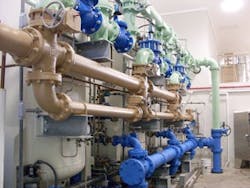Canton, Mass., Achieves Iron, Manganese Filtration
Located 15 miles southwest of Boston, Canton is a town steeped in history. Perhaps most famously, Paul Revere once lived in Canton, and this is the same town where he situated the nation’s first copper rolling mill in 1801.
The water supply for the town of Canton’s population of more than 20,000 is supplied through municipal wells. Until recently, the water from these wells was blended with water purchased from Massachusetts Water Resources Authority.
The town contracted with an engineer to explore cost-saving options. The engineer determined that the town could more fully utilize its own wells by treating the water to remove iron and manganese. This would eliminate the need to blend the local water supply with water purchased from other sources.
Optimal Treatment
At the request of the engineer, Layne Christensen Co. performed a pilot test on the town’s wells in order to determine the optimal treatment. The pilot test demonstrated that a system could be put in place capable of bringing iron and manganese levels well below regulatory requirements while achieving a loading rate as high as 12 gal per minute (gpm)/sq ft.
The high loading rate achieved in Canton’s treatment plant is the result of LayneOx media, a highly efficient granular catalytic filter media with a naturally high manganese dioxide content. The LayneOx process provides the ability to remove iron, manganese and many other contaminants, all in one cost-effective backwash process.
The town of Canton pre-purchased the treatment equipment, which was then installed by the general contractor. Layne fabricated a skid-mounted iron and manganese removal system capable of treating 750 gpm (1 million gal per day). The system is comprised of three 6-ft-diameter vertical vessels that treat the water from two of Canton’s wells. Each vessel contains a 48-in. bed of LayneOx with gravel, and each has automated backwash and integrated air scour.
The treatment plants were designed and constructed at Layne’s UL-certified fabrication facility in Bridgewater, N.J., which maintains an ASME “U” Code Stamp for construction of pressure vessels.
The completed system has been installed and operational since May 2010 and is operating within design parameters. Performance test data from the finished plant demonstrate that iron levels of 0.88 to 0.14 mg/L are reduced to 0.06 to 0.04 mg/L (far below the maximum contaminant level of 0.3 mg/L). Likewise, manganese levels of 0.619 to 0.519 mg/L are reduced to 0.014 to 0.002 mg/L (well below the maximum contaminant level of 0.05 mg/L).
